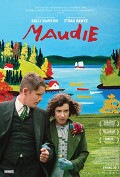
Directed by
Aisling Walsh
115 minutes
Rated M
Reviewed by
Bernard Hemingway

Maudie
Synopsis: Maud Dowley, a social outcast living in a small Nova Scotian fishing village in the 1940s answers an advertisement for a house-keeper posted by illiterate fish peddler Everett Lewis (Ethan Hawke) and an unlikely relationship develops.
I noted somewhere the following synopsis of Maudie: “Canadian folk artist Maud Lewis falls in love with a fishmonger while working for him as a live-in housekeeper”. This summation, if not entirely misguided, does not do justice to Aisling Walsh’s film, for, romance there may be but Maudie is above all a celebration of human tenacity and capacity for compassion and spiritual growth.
Based on real-life Canadian “outsider” artist Maud Dowley (1903-1970) who suffered from crippling rheumatoid arthritis which handicapped her from an early age. Maudie tells the sory of a woman who was treated as a burden by family, ignored by neighbours and mocked by children. Needless to say, despite her appearance she was a human being with a need to give and receive love. This, and the way in which painting became the means of transforming her life, both figuratively and literally, is the concern of this touching film.
Admittedly director Walsh’s approach to Maudie’s story is idealizing and the film has earned some criticism for sugar-coating the poverty and harshness of Maudie’s life (apparently a biography ‘Maud Lewis: The Heart on Every Door’ by Lance Woolaver depicts a far less benign picture of her life). Even if one knows nothing of the real Maudie, a certain romanticisation is at times apparent most notably in the re-construction of Everett from surly Neanderthal (as he explains his priorities to Maudie early in the piece: “There’s me, them dogs, them chickens, then you”), to solicitous spouse thanks to the warm glow of Maudie’s loving attentions but also in small things like the way Maudie’s discovery of painting is presented as a familiar artistic epiphany (in reality she had been taught to paint as child by her mother). It not Driving Miss Daisy glossy there is a sense of the story being assiduously prettified especially thanks to Guy Godfree evocatively picturesque cinematography of the Nova Scotian landscape (panoramic shots of Everett wheeling Maudie home on his two wheel cart her feet dangling over the edge being cases in point).
Then there are more serious internal issues, for example in the way in which a sophisticated New Yorker (Kari Matchett) appears and offers to buy one of Maud’s hand-painted cards. One expects her to turn out to be an art dealer with a canny eye for marketing Maudie's work but nothing comes of this suspicion and it is never explained how Maudie’s career takes off as a result of this event. Also, the way in which (once again unexplained) Everett finds Maudie’s daughter who just happens to be living a short car-ride away feels like another of the scriptwriter Sherry White's glossings.
Ultimately however Sally Hawkin’s performance sweeps all reservations aside. Hawkins had previously worked with the director on Fingersmith, a 2005 BBC tele-series, but she first came to wide public attention as the indefatigably cheery Poppy in Happy-Go-Lucky (2007), There is something of that character here, as Hawkins, never fetishizing Maud’s physical disabilities, focuses more on Maudie's innate optimism, indefatigable courage and generosity of spirit in a stellar performance. A short clip from Diane Beaudry’s National Film Board documentary “Maud Lewis: A World Without Shadows” seen at the end of the film indicates how well Hawkins has captured the spirit of Maud Dowley. Hawkins is being touted as an Oscar nominee but as far as I am concerned she should be given the statuette right now. Although the same clip suggests that Hawkes' performance is more generically brutish, his performance is at least enough against-type to be commendable (Sean Bean who was originally cast would perhaps have been more effective), the two of them together providing a first-class double act. .
Maudie is a sentimental film but in a good way and should be high on your to-see list.
FYI: The Lewis’s 10×12ft cottage is on display at the Art Gallery of Nova Scotia in Halifax.

Want more about this film?


Want something different?




